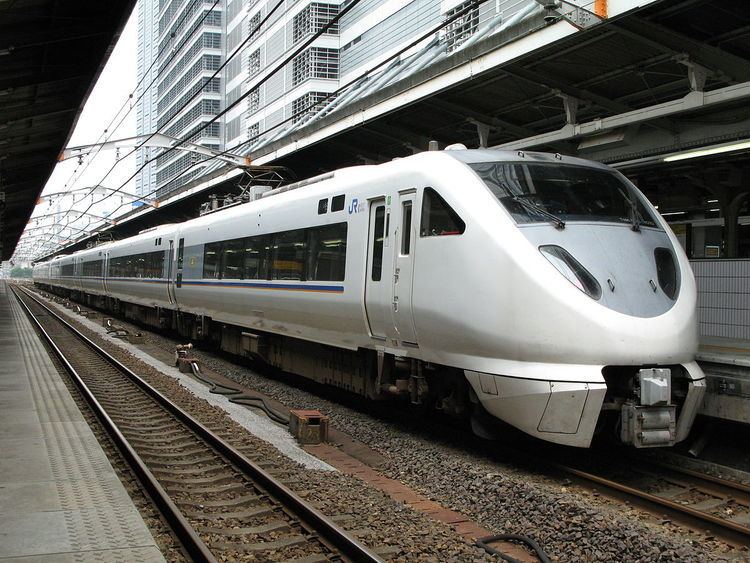 | ||
A-train is Hitachi's brand name for rail rolling stock built and designed using a set of technologies including car-bodies manufactured from friction stir welded double skin aluminium extrusions with built-in mounting rails for sub-assemblies, and self-modular construction using supporting sub-modules. The stock is designed to facilitate a number of product life-cycle improvements including ease of manufacture, increase in energy efficiency, and recyclability.
Contents
Description
The "A Train" design concept includes several elements: the primary feature is the vehicle car bodies constructed from double skin aluminium extruded sections which are friction stir welded, other features of the design are hollow extruded mounting rails on the vehicle body to which modular components are attached.
Initially the A-train family consisted of multiple units designed and built by Hitachi, initially for use on the railway system in Japan. The A-train family comprises trains for both commuter services and limited express services. Hitachi has given the family a modular design which enables both production and refurbishment to be undertaken faster. The A-train's strong body is the result of the use of revolutionary technology called friction stir welding (FSW). Due to the low heat input of this patented process high strength, excellent crashworthiness and minimal distortion can be achieved.
Japanese trains
Hitachi has provided a number of trains based on the A-train concept for use in Japan:
A-train overseas
Hitachi have been marketing the A-train family overseas. Both the Chongqing Monorail in China and the Sentosa Express Monorail in Singapore utilise A-train derived cars. However, Hitachi's first major conventional rail order outside Japan came when Southeastern ordered a total of 29 EMUs for use running the domestic services on High Speed 1 in the United Kingdom. The Class 395 units are standard gauge and designed to operate at speeds of up to 225 km/h (140 mph).
At approximately the same time as the UK order, Hitachi received an order from Taiwan Railway Administration (TRA) for six 8-car trains, based on the Japanese 885 series, designated as TEMU1000, for operation on the main line between Taipei and Hualien. Deliveries of the trains began in late 2006, with the first public test of the new trains in March 2007.
In 2007, Korail ordered eight 4-car express trains branded as the Trunk-Line Electric Car (TEC) to Hitachi. These car body, bogies, power systems made in Japan, but were to be assembled at SLS Heavy Industry in Changwon, Korea. and, a significant amount of the components have been replaced by a Korean part. The trains were for deployment on "Rapid Train" services on the Gyeongbu Line and Janghang Line between Seoul station and Sinchang Station, branded Nuriro and with a maximum speed of 150 km/h.
Hitachi gained further ground in the UK market when it was announced that an A-train based design similar to that of the Class 395, initially named the "Hitachi Super Express", won the United Kingdom Government's Intercity Express Programme tender. The order covers up to 1,400 new multiple unit vehicles, commissioned as five- and nine-car sets. The Class 801 EMU sets will operate only on electrified sections of the network, and the Class 800 EDMU (electro-diesel multiple unit) "bi-mode" sets will be powered by AC overhead where available and underfloor diesel generators beyond the extents of electrification. The train specification allows for the conversion of Class 800 to Class 801, as it is assumed that electrification will continue to expand.
The choice of Hitachi units, which would see little final manufacturing in the UK over the foreign-owned but domestically manufactured Bombardier option, was controversial, particularly in the area that would have manufactured them, leading to a campaign to reverse the decision. It was, however, economics which became a sticking point with the weight of the design creeping up (though some accused the Dft of producing impossible specification requirements) and reportedly difficult negotiations over the final unit price and production balance between the different power options. The inability or reluctance of the financial markets to provide the necessary capital was the final straw, leading to the announcement in February 2010 of a three-month independent review into the value for money of the programme and looking at alternative options such as life extension of existing IC125 stock.
Hitachi has a range of options in the UK with the Hitachi AT300 long distance/high speed, for example Class 395, Class 800 and Class 801.
In March 2015 First Great Western (GWR) agreed to acquire 29 bi-mode Hitachi AT300 (Class 802) subject to government approval expected in June 2015. The trains, which will consist of 22x 5-car and 7x 9-car units, will be a replacement for the remaining HST fleet. They will make use of the full power output to cope with gradients in Devon and Cornwall (enhanced diesel rating) and will also be built with larger fuel tanks. The trains will use overhead electric power between Paddington and Newbury, which is as far as electrification will reach on the Westbury route.
The AT100 is targeted at high-density urban trains, whilst the AT200 is designed for suburban, commuter and regional routes. Abellio ScotRail has selected the Hitachi AT200 for new trains when it is operating the Scotrail franchise.
